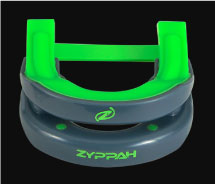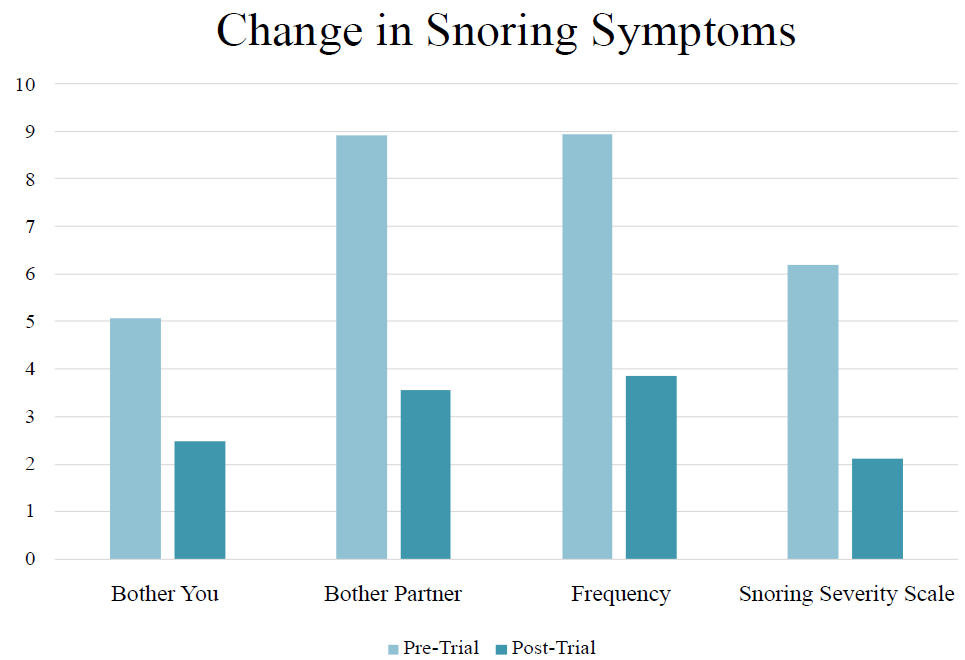Habitual snoring affects millions of individuals and their partners, but often goes unresolved due to the high cost of care and other barriers to treatment. The purpose of this study was to evaluate the effectiveness of a novel intraoral device that restrains the tongue in an over-the-counter setting in a population of habitual snorers.
Individuals who self-reported snoring enrolled in the study and were sent an investigational device. After signing the informed consent, they completed an initial questionnaire about their symptoms and another following 10 days of using the device.
A total of 570 individuals completed the study. A significant improvement was noted in the Snoring Severity Scale (67%), how much snoring bothered the individual (52%), and how much snoring bothered the partner (60%), and the frequency of snoring (57%). In total, 91% of users reported benefits from the device. No adverse events were noted, and fewer than 1% reported issues with the fit of the device.
Use of an intraoral device that restrains the tongue demonstrated significant benefit in the reduction of snoring symptoms among habitual snorers. The device does not reposition the mandible, reducing the risk of temporomandibular joint (TMJ) or facial pain. No significant differences were noted in the effectiveness of the device based on body-mass index, age, or gender.
This study demonstrates a novel, affordable, over-the-counter device was able to significantly improve the symptoms of snoring for both individuals and their partners.
Snoring occurs when vibrations of the pharyngeal airway create a respiratory sound during sleep. Snoring is associated with other sleep disorders like sleep apnea and hypopnea, but does not necessarily indicate the presence of a more serious sleep disorder. The prevalence of snoring has been estimated at 25-40% of the overall population [1]. Risk factors for snoring include obesity, use of alcohol/tranquilizers, smoking, nasal obstruction, and the male sex [2].
The impact of snoring is often born by the partner of the habitual snorer. One study reported that more than half of partners were often disturbed by the snoring and 35% reported it caused relationship problems. Of those bothered by their partners snoring, 40% responded by sleeping in separate bedrooms at least once a week, while about one-quarter tried sleep aids like ear plugs, sleeping pills, or other interventions [3]. Partners of snorers have reported more morning headaches, fatigue, and daytime sleepiness [4].
Snoring often goes untreated unless it is accompanied by evidence of a more serious sleep disorder or a patient specifically requests treatment. Often the initial steps in treatment are self-care techniques, including losing weight, reducing alcohol intake, or changes in sleeping position. However, low compliance means these techniques often are not enough to manage snoring.
A dentist or physician can also prescribe an intra-oral device, often one that functions by repositioning the mandible forward to increase airway space. These can be effective in reducing snoring for some patients, but are expensive, require a prescription, and can have side effects like excessive salivation, TMJ pain, dental pain, and bite change. In fact, between 50 and 82% of patients with mandibular repositioning devices reported at least one side effect with use [5].
Continuous positive airway pressure (CPAP) machines are highly effective at treating snoring, but compliance is extremely low due to discomfort of wearing the device and the noise that it generates. In one study, fewer than 20% of patients accepted a CPAP machine to treat their snoring [6]. Patients have been shown to be almost three times as likely to choose an intraoral device to manage their snoring, rather than a CPAP machine [7].
With the barriers to treatment, many habitual snorers do not seek treatment or find relief. This study evaluates a relatively inexpensive oral mouthpiece that does not require a prescription to reduce snoring. Instead of advancing the mandible, the novel device restrains the tongue during sleep, increasing airflow through the airway. It is customized to each patient with a ‘boil-and-bite’ fitting method, and is simple to use.
This study evaluates the safety and effectiveness of this device as it would be used as an over-the-counter treatment option. The device is purchased online and shipped to the patient, who fits the device to their own mouth and begins to use it. In this study, the subject completes an initial questionnaire prior to receiving the device and another after 10 days of use.
The investigational device (Zyppah Anti-Snoring Device) (Figure 1) is an intraoral mouthpiece designed to reposition the tongue and improve the airway to reduce snoring. It features a patented strap that stretches across the device to hold back the tongue during sleep.
 Figure 1: Zyppah device. View Figure 1
Figure 1: Zyppah device. View Figure 1
Subjects enrolled in the study online. After filling out an online questionnaire to determine their initial symptoms and signing the informed consent, the product and instructions were shipped to them.
The device was used for a period of 10 days during this clinical trial. An email prompted subjects to complete a follow-up questionnaire was sent ten days after the device was received.
Subjects were not paid to participate in this study. The cost of the device was refunded to patients upon completion of the final questionnaire of the study.
The first primary endpoint in this study was the change in the validated Snoring Severity Scale [8,9]. The Snoring Severity Scale (SSS) asks three questions of the subject and their partner: 1) How often do you snore, 2) How long do you snore, and 3) How audible is your snoring with the door shut? The responses to these questions are rated on a scale of 0 to 3, and the entire scale is scored out of 9 possible points, where a ‘9’ represents the worst possible score.
In order to assess the impact of snoring on the quality of life of both the subject and their partner, additional primary endpoints were an assessment of snoring using a validated Visual-Analogue Scale (VAS) [10-13]. The questions asked of patients on a 1-10 VAS were:
• How much does your snoring bother you?
• How much does your snoring bother your partner? (If applicable)
• How frequently do you snore?
A two-sample paired t-test was used to compare results before and after the trial and determine statistical significance. Data was considered statistically significant when the p-value was < 0.05.
A one-sample binomial test was used to analyze data where subjects reported their satisfaction with the device to ensure that the results of that binary question were significantly more than would be expected by chance.
In analyzing the effects of gender, age, and body mass index, data that was within a single standard deviation of the average was considered insignificant, as it would be expected to be within a single standard deviation under a normal distribution 68.2% of the time. If data was greater than a single standard deviation it was acknowledged, but not considered statistically significant. Data was only considered to be statistically significant if exceeded two standard deviations from the average (95% confidence interval).
The study was approved by Western Institutional Review Board and reported to Clinical Trials.gov (NCT03128307).
A total of 621 subjects completed the initial questionnaire, signed the Informed Consent, and were enrolled into the study. Of those subjects, 604 received the device and participated in the study, and 570 (91.8%) completed the study.
Of those that completed the study 105 were women and 465 were men, mirroring the higher risk of snoring in the male population. The average and median age of the subjects was 48 years of age, ranging from 22 to 77 years. The average body-mass index (BMI) was 30.83 with a median of 29.84 and a range of 18.60 to 53.70.
On average, women reported having snoring symptoms for 11.5 years and men for 13.3 years.
Many of these patients had tried other means to reduce their snoring: 140 (25%) had tried a mouthguard or dental appliance with a 36% success rate. Another 130 (23%) patients had tried nasal strips and 9 had used nose plugs, 21 (3.7%) used a CPAP machine, 31 (5.4%) tried a nasal spray, 39 (6.8%) used a jaw/chin strap, 21 (3.7%) bought pillows, and still others tried additional methods to prevent snoring (2 used straps or suction to position the tongue, one had acupuncture, one had surgery and 9 bought a new bed). Many people tried multiple treatments without success. Finally, 132 (23%) had a prior sleep study to determine if they had sleep apnea (Table 1 and Table 2) (Figure 2).
Table 1: Change in snoring severity scale. View Table 1
Table 2: Change in visual-analogue scale during trial. View Table 2
 Figure 2: Change in Snoring symptoms. View Figure 2
Figure 2: Change in Snoring symptoms. View Figure 2
In broad questions in the final survey, a total of 91% of subjects self-reported improvement. This is statistically significant regardless of whether the expectation was 50% of subjects reporting improvement (p < 0.000001) or 75% (p < 0.000001) using a one-sample binomial test.
When asked about their satisfaction with the device, 78% of users reported being satisfied with the device, and 84% would recommend the device to a friend or family member struggling with snoring. The overall effectiveness of the device was rated a 7.14 (out of 10) by users on a Visual-Analogue Scale.
A total of 139 subjects reported that they had tried another mouthpiece to improve their snoring, but only 3 (2%) reported that it had been effective in eliminating their snoring. This group performed just as well in the trial as those who had not tried a mouthpiece before (p = 0.5), reporting an average improvement in sleep scoring scale of 4.15 (vs. 4.31 for those who hadn’t tried a mouthpiece before), suggesting the investigational device offers a unique benefit to subjects who have not seen a benefit with other mouthpieces.
No significant adverse events were reported in this study. A total of 5 subjects (< 1% ) reported they were unable to get a comfortable fit with the device. One patient reported that one side of the elastic strap the holds back the tongue separated during the study.
Use of a novel intraoral device to reposition the tongue and open the airway during sleep resulted in significant improvements in snoring. Subjects reported significant improvements of at least 50% on all primary endpoints in this study. No significant differences were noted in response to treatment based on age, BMI, or gender.
More than 90% of habitual snorers self-reported improvement with use of the device. Users who had previously reported trying other intraoral devices without success performed just as well in this trial as those who had not attempted another intervention, suggesting the investigational device may have benefits for patients beyond those of traditional treatments.
Dr. Jonathan Greenburg is the Founder and CEO of Zyppah, Inc., the developer of the Zyppah Anti-Snoring device. The other authors have no conflicts of interest to report.
All named authors have materially contributed to this research and approve of the version to be published.